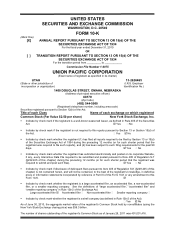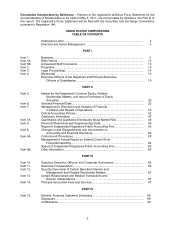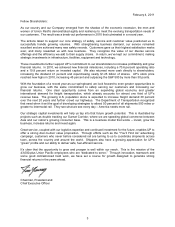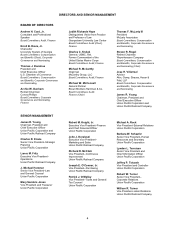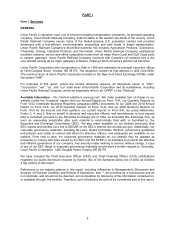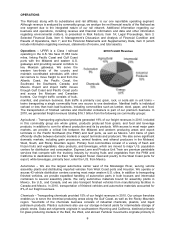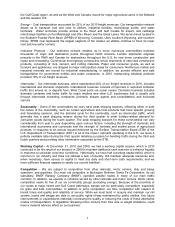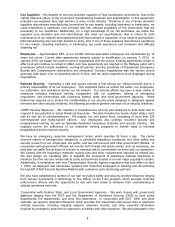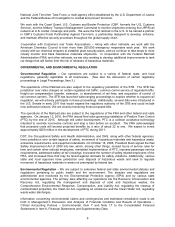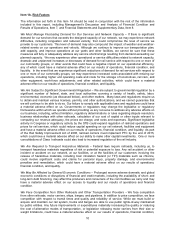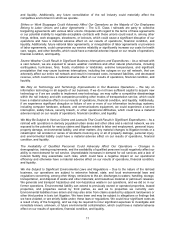Union Pacific 2010 Annual Report Download - page 10
Download and view the complete annual report
Please find page 10 of the 2010 Union Pacific annual report below. You can navigate through the pages in the report by either clicking on the pages listed below, or by using the keyword search tool below to find specific information within the annual report.
10
Item 1A. Risk Factors
The information set forth in this Item 1A should be read in conjunction with the rest of the information
included in this report, including Management’s Discussion and Analysis of Financial Condition and
Results of Operations, Item 7, and Financial Statements and Supplementary Data, Item 8.
We Must Manage Fluctuating Demand for Our Services and Network Capacity – If there is significant
demand for our services that exceeds the designed capacity of our network, we may experience network
difficulties, including congestion and reduced velocity, that could compromise the level of service we
provide to our customers. This level of demand may also compound the impact of weather and weather-
related events on our operations and velocity. Although we continue to improve our transportation plan,
add capacity, and improve operations at our yards and other facilities, we cannot be sure that these
measures will fully or adequately address any service shortcomings resulting from demand exceeding our
planned capacity. We may experience other operational or service difficulties related to network capacity,
dramatic and unplanned increases or decreases of demand for rail service with respect to one or more of
our commodity groups, or other events that could have a negative impact on our operational efficiency,
any of which could have a material adverse effect on our results of operations, financial condition, and
liquidity. In the event that we experience significant reductions of demand for rail services with respect to
one or more of our commodity groups, we may experience increased costs associated with resizing our
operations, including higher unit operating costs and costs for the storage of locomotives, rail cars, and
other equipment; work-force adjustments; and other related activities, which could have a material
adverse effect on our results of operations, financial condition, and liquidity.
We Are Subject to Significant Governmental Regulation – We are subject to governmental regulation by a
significant number of federal, state, and local authorities covering a variety of health, safety, labor,
environmental, economic (as discussed below), and other matters. Many laws and regulations require us
to obtain and maintain various licenses, permits, and other authorizations, and we cannot guarantee that
we will continue to be able to do so. Our failure to comply with applicable laws and regulations could have
a material adverse effect on us. Governments or regulators may change the legislative or regulatory
frameworks within which we operate without providing us any recourse to address any adverse effects on
our business, including, without limitation, regulatory determinations or rules regarding dispute resolution,
business relationships with other railroads, calculation of our cost of capital or other inputs relevant to
computing our revenue adequacy, the prices we charge, and costs and expenses. Significant legislative
activity in Congress or regulatory activity by the STB could expand regulation of railroad operations and
prices for rail services, which could reduce capital spending on our rail network, facilities and equipment
and have a material adverse effect on our results of operations, financial condition, and liquidity. As part
of the Rail Safety Improvement Act of 2008, railroad carriers must implement PTC by the end of 2015,
which could have a material adverse effect on our ability to make other capital investments. One or more
consolidations of Class I railroads could also lead to increased regulation of the rail industry.
We Are Required to Transport Hazardous Materials – Federal laws require railroads, including us, to
transport hazardous materials regardless of risk or potential exposure to loss. Any rail accident or other
incident or accident on our network, at our facilities, or at the facilities of our customers involving the
release of hazardous materials, including toxic inhalation hazard (or TIH) materials such as chlorine,
could involve significant costs and claims for personal injury, property damage, and environmental
penalties and remediation, which could have a material adverse effect on our results of operations,
financial condition, and liquidity.
We May Be Affected by General Economic Conditions – Prolonged severe adverse domestic and global
economic conditions or disruptions of financial and credit markets, including the availability of short- and
long-term debt financing, may affect the producers and consumers of the commodities we carry and may
have a material adverse effect on our access to liquidity and our results of operations and financial
condition.
We Face Competition from Other Railroads and Other Transportation Providers – We face competition
from other railroads, motor carriers, ships, barges, and pipelines. In addition to price competition, we face
competition with respect to transit times and quality and reliability of service. While we must build or
acquire and maintain our rail system, trucks and barges are able to use public rights-of-way maintained
by public entities. Any future improvements or expenditures materially increasing the quality or reducing
the cost of alternative modes of transportation, or legislation releasing motor carriers from their size or
weight limitations, could have a material adverse effect on our results of operations, financial condition,

